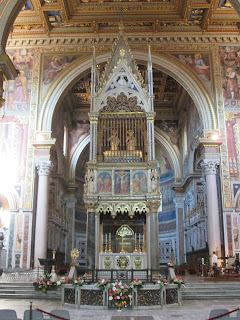 |
Our three Franciscan Sisters behind the statue of St. Francis
and his brother friars.
The façade of the Lateran is in the back,
with the one-time papal residence on the right side. |
On the last day of June, we experienced the hottest day yet of our time. But we set out with anticipation for the Lateran Basilica for Mass and a tour. It was interesting to note that the basilica was originally named for the Most Holy Savior and housed the Holy Father until the papacy moved to Avignon, France, during the 14th Century.
 |
| Statue of St. Francis supporting the Church. |
When St. Francis was seeking approval for his concept of a radical following of the Gospel, he had an audience with Pope Innocent II. Initially, the pope was hesitant to grant his request, but that night he had a dream in which he saw Francis holding up the Lateran, by which he understood that this man would be instrumental in reviving the faith in the universal Church. This statue was created to portray that dream.
A focal point of the Lateran Basilica is the ornate baldacchino in which are housed two bronze busts of the holy apostles Peter and Paul, containing relics of their skulls. Because the altar is the privileged place on which we celebrate Christ's redemptive act, the baldacchino draws our eyes upward symbolizing the connection between heaven and earth that takes place during the Holy Sacrifice of the Mass.
 |
| A tour of the Lateran from a priest who serves in the Basilica |
 |
| Cathedra of the Holy Father |
The most important aspect of the Lateran Basilica is the
cathedra of the Bishop of Rome, located behind the altar.
Cathedra in Latin stands for "chair" and represents the authority of a bishop in his diocese. Since Pope Francis is not only the leader of the universal Church but also the Bishop of Rome, this church is his cathedral, rather than St. Peter's Basilica.
After viewing St. John Lateran, the Sisters split into two groups. One group went to Santa Scala - the Holy Stairs - and prayerfully ascended the steps on their knees. According to tradition, the stairs were brought by St. Helena, the Mother of Emperor Constantine, to Rome from the Praetorium in Jerusalem where Jesus experienced His Passion. Blood stains are still visible on the stairs.
 |
| Baptistry of St. John Lateran Basilica |
Meanwhile, the second group of Sisters toured the baptistry of St. John Lateran. Baptisms have been held in this spot of the basilica for centuries. The Sisters were delighted that during their visit they witnessed a baptism in process.
 |
| Façade of Santa Croce in Gerusalemme |
Our last stop for the morning was
Santa Croce in Gerusalemme (The Holy Cross in Jerusalem). This church houses the relics of Jesus' Passion, including fragments of the Cross, a nail, thorns, the
Titulus Crucis (INRI inscription), soil from Jerusalem, the cross beam of St. Dismas (the Good Thief) and the finger of doubting Thomas, who probed Jesus' side after the Resurrection. It was a solemn and prayerful experience. Photos were prohibited, but you can find more about the church at
http://www.sacred-destinations.com/italy/rome-santa-croce-in-gerusalemme.
With our hearts full of joy and the richness of our experience, we headed back to the Domus on the bus for lunch and a presentation on the history of sites we will visit soon. In the evening, a number of Sisters also took in a concert by Long Beach Choral Arts Tour Choir at the Church of Sant'Agnese in Agone. The Choir was composed of students from three high schools in the Long Beach, California, area. They were fantastic!










No comments:
Post a Comment